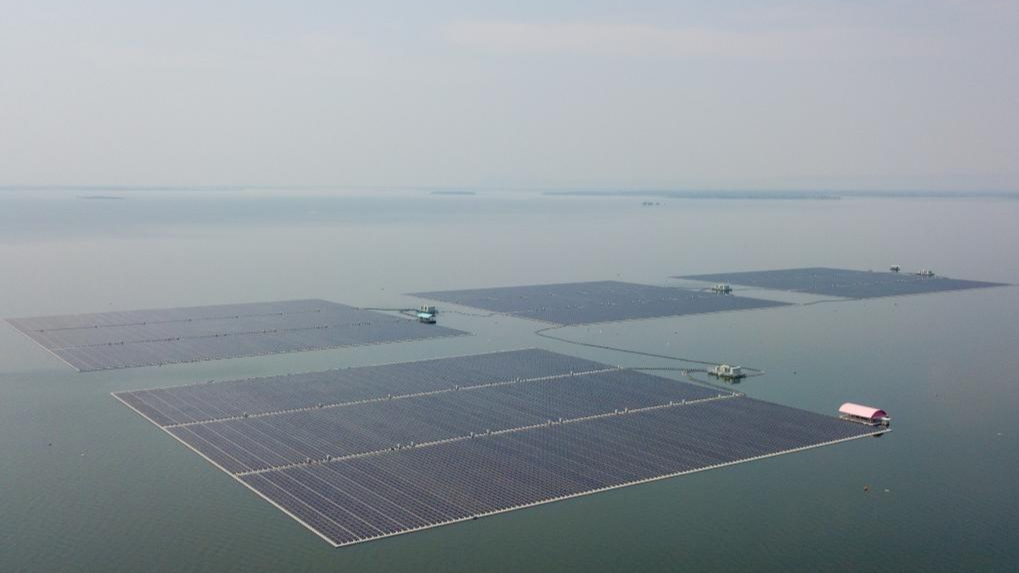
The Ubolratana Dam hydro-floating solar hybrid power plant jointly built by Chinese and Thai companies in Khon Kaen, Thailand, March 5, 2024. [Photo/Xinhua]
By Yi Xin
The global green energy industry is witnessing unprecedented growth, with the solar photovoltaic (PV) sector leading the trend. As the world races to combat climate change, countries are increasingly investing in renewable energy, with China emerging as a key player due to its strong manufacturing capacity. As International Energy Agency (IEA) Executive Director Fatih Birol said, "We are now in a world where almost every energy story is essentially a China story."
China is shining in the spotlight. Despite skepticism regarding its role in the global energy transition, one cannot write off the broader benefits that China brings to the table. Beyond satisfying domestic demand, China's PV panel production is a significant contributor to the global energy transition, offering affordable and clean energy solutions to other countries.
Illuminating continents with solar power
China plays a wide role in today's PV industry. In Africa, the "Africa Solar Belt" program announced in September 2023, for which China is funding about $14 million, will bring solar energy to at least 50,000 off-grid families, offering a better life and a transition to green energy.
In Asia, Pakistan is installing solar farms with Chinese collaboration; in Malaysia, Chinese PV company Trina Solar's floating solar panel project has brought advanced technologies. In Latin America, the Marangatu Solar Complex developed by China's State Power Investment Corporation in Brazil and Recurrent Energy powers approximately 550,000 homes annually, and has created 1,500 direct jobs and 500 indirect ones.
In Europe, the Senj Wind Farm in Croatia, undertaken by China's Norinco International, has cut Croatia's annual carbon dioxide emissions by around 460,000 tons since its inauguration in 2021, and generates affordable green electricity to meet the demands of over 100,000 households.
Stories like these keep emerging. China's public and private efforts have not only provided affordable and clean energy and employment opportunities, but also laid the groundwork for further infrastructure development in these nations, showcasing the opportunities brought by China's PV industry to the rest of the world.

A wind turbine blade at the construction site of the Senj Wind Farm in Senj, Croatia, September 27, 2020. [Photo/Xinhua]
Embracing a low-carbon future
The growth of China's PV industry is a positive force in achieving the United Nations Sustainable Development Goals (SDGs), particularly SDG 7, which aims to ensure access to affordable, reliable, sustainable and modern energy for all. The IEA reported that solar PV accounted for three quarters of global renewable capacity additions in 2023, with China being a significant contributor. This growth is crucial for meeting the climate change mitigation goals set forth in the Paris Agreement.
United efforts worldwide are imperative to realize green energy transition. With China being a key provider in this global endeavor, the world should embrace this collaboration with open arms.
China has shown unwavering commitment and persistent efforts to transform its energy sector, strengthen climate cooperation, lead emission reductions, and enhance public awareness. Its initiatives include the carbon peaking and carbon neutrality goals set in 2020, the continued emphasis on social and economic green transition, and the updated white paper in 2024 on its energy transition. These are not driven by national self-interest only, but by a conviction that all countries share a stake in a green future.
Uniting for a greener world
However, it is crucial to recognize that despite its rapid growth, the capacity of China's PV industry is still insufficient to fill the global green energy gap on its own. This highlights the need for concerted global efforts to address this challenge.
UN data show that in 2021, 675 million people still lacked access to electricity. For those in urgent need of low-cost clean energy, where the energy has originated is not the point. The point is fair access to affordable energy, fair opportunities to build better infrastructure, and a fair chance to live and thrive. The growth of one country's PV industry is not and should not be a threat to the world. Instead, it should be a ray of hope enabling all countries, especially developing ones, to leapfrog towards a sustainable future.
Yi Xin is a Beijing-based international affairs commentator.

 中文
中文



